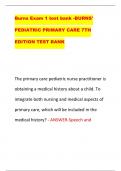Samenvatting
Summary Extensive lecture notes of Neuropsychology & Psychiatric disorders
- Instelling
- Rijksuniversiteit Groningen (RuG)
Extensive lecture notes of Neuropsychology & Psychiatric disorders, including information from all 7 lectures, from slide + lecturers.
[Meer zien]













